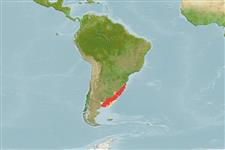Common names from other countries
Classification / Names / Names
ماع يماسا | فدارتم | Catalog of Fishes (gen., sp.) | ITIS | CoL | WoRMS
Environment: milieu / climate zone / depth range / distribution range
يسانش موب
; قمع تارييغت 0 - 90 m (Ref. 275). Subtropical; 30°S - 44°S, 65°W - 50°W (Ref. 107078)
Southwest Atlantic: from Brazil to Argentina.
Length at first maturity / Size / Weight / نس
Maturity: Lm ? range ? - ? cm Max length : 30.0 cm TL يسنج صاوخ نودب / رن سنج; (Ref. 105659)
Minimum depth assumed from its ecology. Inhabits intertidal and shallow subtidal zones, on reefs and sandy areas. Found on crevices, boulders and empty gastropod and bivalve shells. Selectively feeds on grapsid crabs and small bivalves. Known to extract living hermit crabs on gastropod shells via drilling. Major source of food for juvenile shark in Argentinean waters (Ref. 96968).
Life cycle and mating behavior
غولب | لثم دیلوت | یزیر مخت | اه مخت | Fecundity | )ورال ( دازوت
Members of the class Cephalopoda are gonochoric. Male and female adults usually die shortly after spawning and brooding, respectively. Mating behavior: Males perform various displays to attract potential females for copulation. During copulation, male grasp the female and inserts the hectocotylus into the female's mantle cavity where fertilization usually occurs. Life cycle: Embryos hatch into planktonic stage and live for some time before they grow larger and take up a benthic existence as adults.
یلصا ذخآم
عجارم | هدننك گنهامه | ناراكمه
Roper, C.F.E., M.J. Sweeney and C.E. Nauen. 1984. (Ref. 275)
NCUI زمرق تسرهف رد تيعضو (Ref. 130435)
ستياس رظن زا تيعضو (Ref. 108899)
Not Evaluated
Not Evaluated
یناسنا هدافتسا
تاليش – يريگ يهام: يراجت
| FishSource |
اهرازبا
رتشيب تاعالطا
Age/Sizeدشرنزو - لوطلوط - لوطيسانش تخير)ورال ( دازوتيناوارف
يتنرتنيا عبانم
Estimates based on models
Preferred temperature
(Ref.
115969): 10.8 - 17.6, mean 14.7 (based on 106 cells).
یريذپ بيسآ
Low vulnerability (10 of 100).
